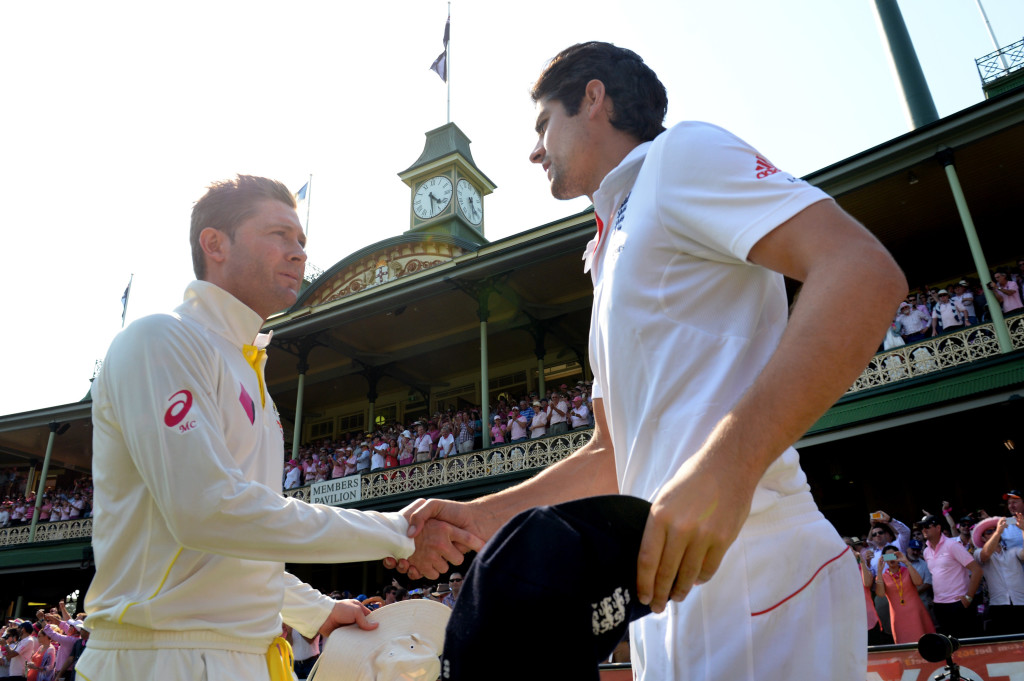On the eve of the eagerly awaited first Ashes Test, SACricketmag.com explores five things that could define the illustrious five-match contest. By Tom Sizeland.
1. JOBS AND REPUTATIONS ARE ON THE LINE
Chris Rogers has confirmed he will retire after the Ashes, and in all likelihood Brad Haddin will follow suit. There are others, however, who might not be given a choice. It is widely known that Australia are losing patience with Shane Watson. He hasn’t scored a Test century since December 2013 and the brain trust still can’t figure out where he should bat. With Steve Smith now settled at 3, Watson is set to feature at 6, but a poor series could signal the end of his five-day career. A fourth series defeat as skipper might be all a bit too much for Michael Clarke, too. Some big knocks are required from the longest serving players in the side.
Opposite number Alastair Cook has quietened his critics somewhat since the 5-0 whitewash. He is the leading run-scorer in Test matches this year with two centuries and four fifties in 10 innings. It will be interesting though to see how he fits into England’s energised and refreshed frame of mind following their ODI series triumph over New Zealand. If he can’t fit into the philosophy, and his form as a batsman and a captain suffer as a result, the fickle English faithful might turn their backs on him once again.
Arguably, the most exciting comparisons will be drawn between that of Joe Root and Steven Smith. They bring with them stellar reputations into the series as two of the world’s finest young batsmen. Almost half of Smith’s Test career has been against England, and the English will feel they’ve got the better of him on more occasions than not. His first two centuries came against them however and he has dramatically improved ever since, forcing his way up to No 1 in the world. Root’s progress has been more steady, but he is easily England’s most exciting talent, with both players averaging in the mid-fifties. Reputations could be enhanced, but very easily slashed, for both players in this series.
2. THE VERBAL GAME
Like it or not, the Baggy Greens’ verbal game was ruthless but effective in the whitewash Down Under. Mitchell Johnson’s aggression, paired with Brad Haddin and David Warner’s relentless jibes behind the stumps, was all too much for the English, and while the mind-games got the Aussies into trouble on the odd occasion off the field, it was an approach they staunchly stand by.
Nothing has changed for them leading up to this series. Haddin has revealed he can’t understand all the fuss about England’s ‘resurgence’, and Johnson has vowed to carry on sledging. These are simply mind games. England paceman James Anderson has called for a repeat of the good spirit that characterised the New Zealand series. The tourists aren’t buying it, and they will try to get inside the English heads again. If England can block it out and concentrate on the match itself, it will go a long way towards getting the best out of the individuals. The home support will play a huge role in that.
3. THE PACE BATTLE
The 2013/14 Ashes was all about one man – Mitchell Johnson. He will be expected to lead the pace attack once more, but another left-armer will be hoping to overshadow him. Mitchell Starc has much to prove in the Test arena after he was named the World Cup player of the tournament. The untimely retirement of Ryan Harris will probably leave Peter Siddle and Josh Hazelwood to battle it out for the third seamer spot. Johnson’s terrifying pace and bounce will complement Starc’s equally destructive pace and full, swinging deliveries. There’s a lot for the English batsmen to think about.
England will feel they have competitive armoury themselves in Anderson and Broad. Broad has an excellent record against the Aussies with 63 wickets from 17 matches. Mark Wood will be a willing accessory in the attack, and bears striking similarities to Simon Jones from the side of 2005 – largely untested, a short bursting run-up and the ability to reverse swing. But if Steven Finn gets selected instead, he will feel he has a lot to prove.
4. SELECTION HUNCHES
Both sides have some important selection decisions to make. Australia need to decide who to open alongside Warner. Rogers will be the favourite, but Shaun Marsh might feel hard done by. Marsh can also play further down the order, and could well slug it out with Adam Voges at 5, although Voges became the oldest Australian Test centurion on debut not so long ago. Whoever plays at 5 for Australia will be expected to score big runs. Who will their third seamer be? Do they dare leave out Starc? Do they go with the experience of Siddle at the expense of the promise that is Hazlewood? It is these types of hunches that could play a big role throughout.
England have two decisions to make. A spinner and a third seamer. The selection panel will in all likelihood be cagey and go for consistency in picking Moeen Ali and Mark Wood. They are clearly uncertain with both by selecting respective back-up options in Rashid and Finn. Both could well play a significant role at some stage in the series, but probably not on day one at Cardiff.
5. THE HAUNTED PAST
Australia won’t exactly need to be asked twice to get pumped up, and the driving force behind their motivation will be the near-misses they have endured ever since they last won a series in England in 2001. The famous 2005 series could have gone very differently, as could have the 2009 Ashes, where Monty Panesar and Anderson survived 10 overs to draw the first Test, which spurred them on to capture the series 2-1. England have also made Lord’s their haven against Australia since changing it from the first Test to the second in the schedule. They won for the first time against them in 75 years in 2009, before beating them handsomely once again in 2013.
For England, their motivation will simply be based on wanting to regain the Ashes, and prove that they really have turned a new leaf since their 5-0 drubbing Down Under and their poor World Cup displays. An interesting sub-plot will be Finn, who could get picked purely on his desire to prove a point. He last played a Test match exactly two years ago, against Australia. He’s fixed his stump-crashing technique, and he’ll be desperate to prove everyone that he’s better for it.







